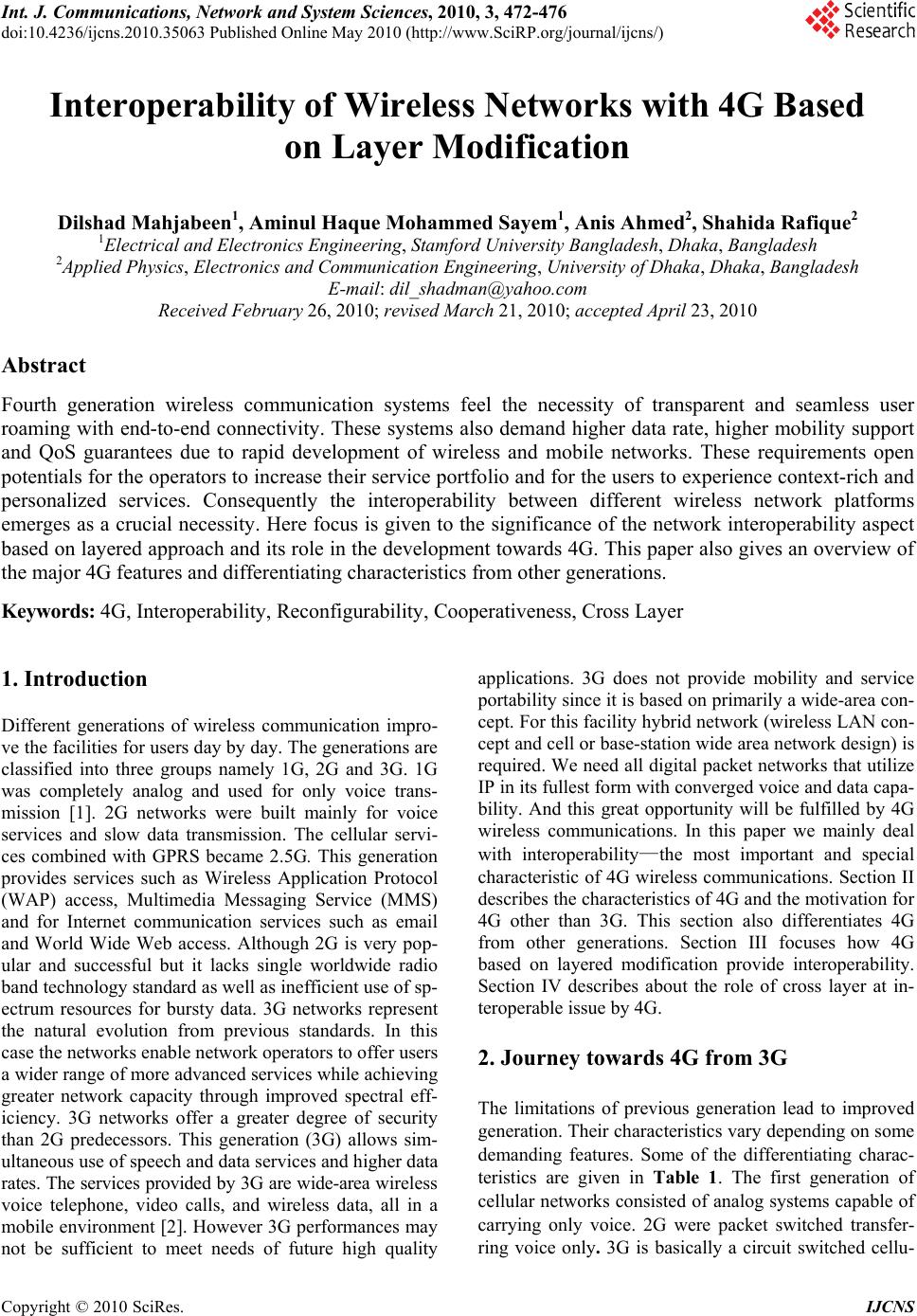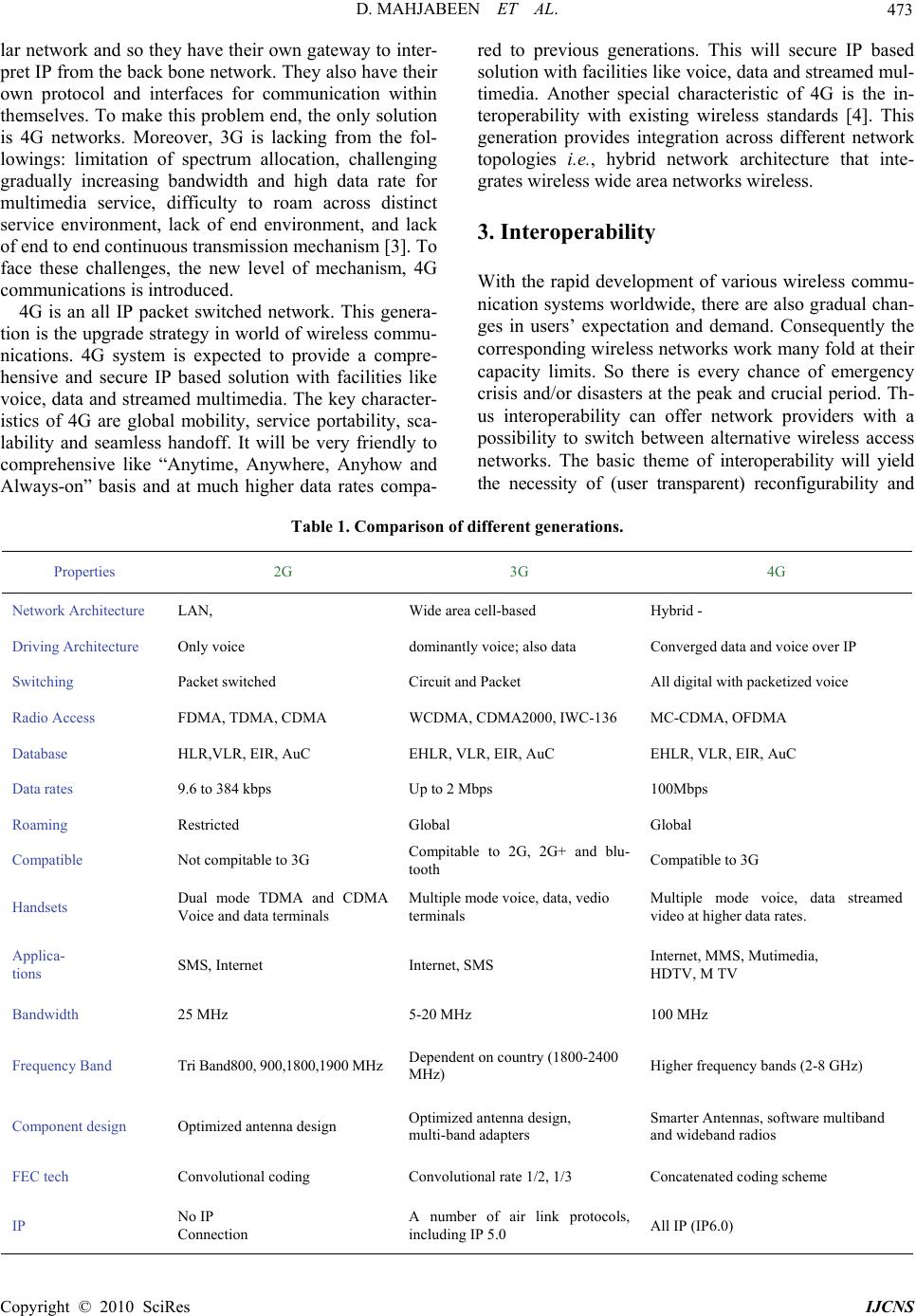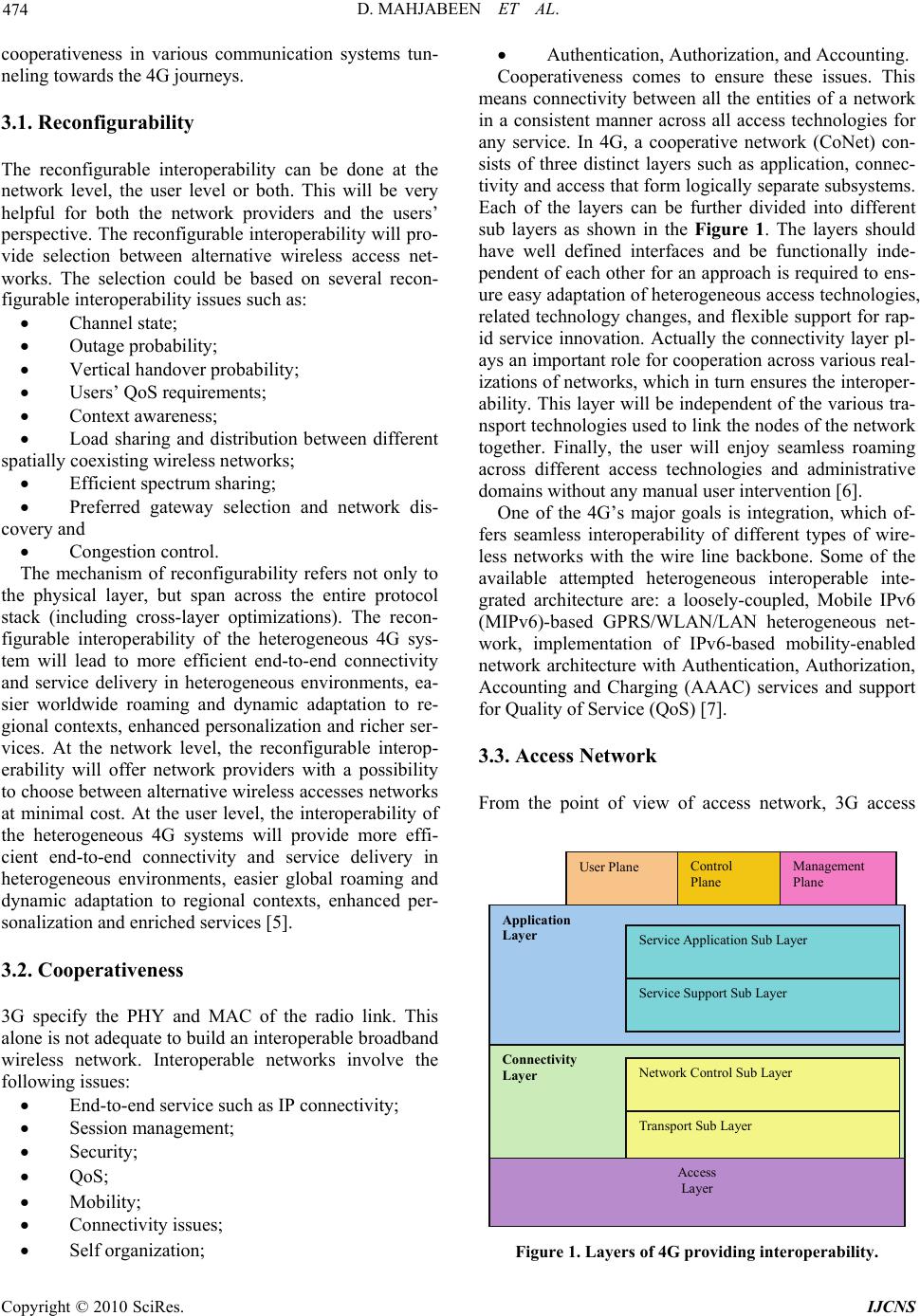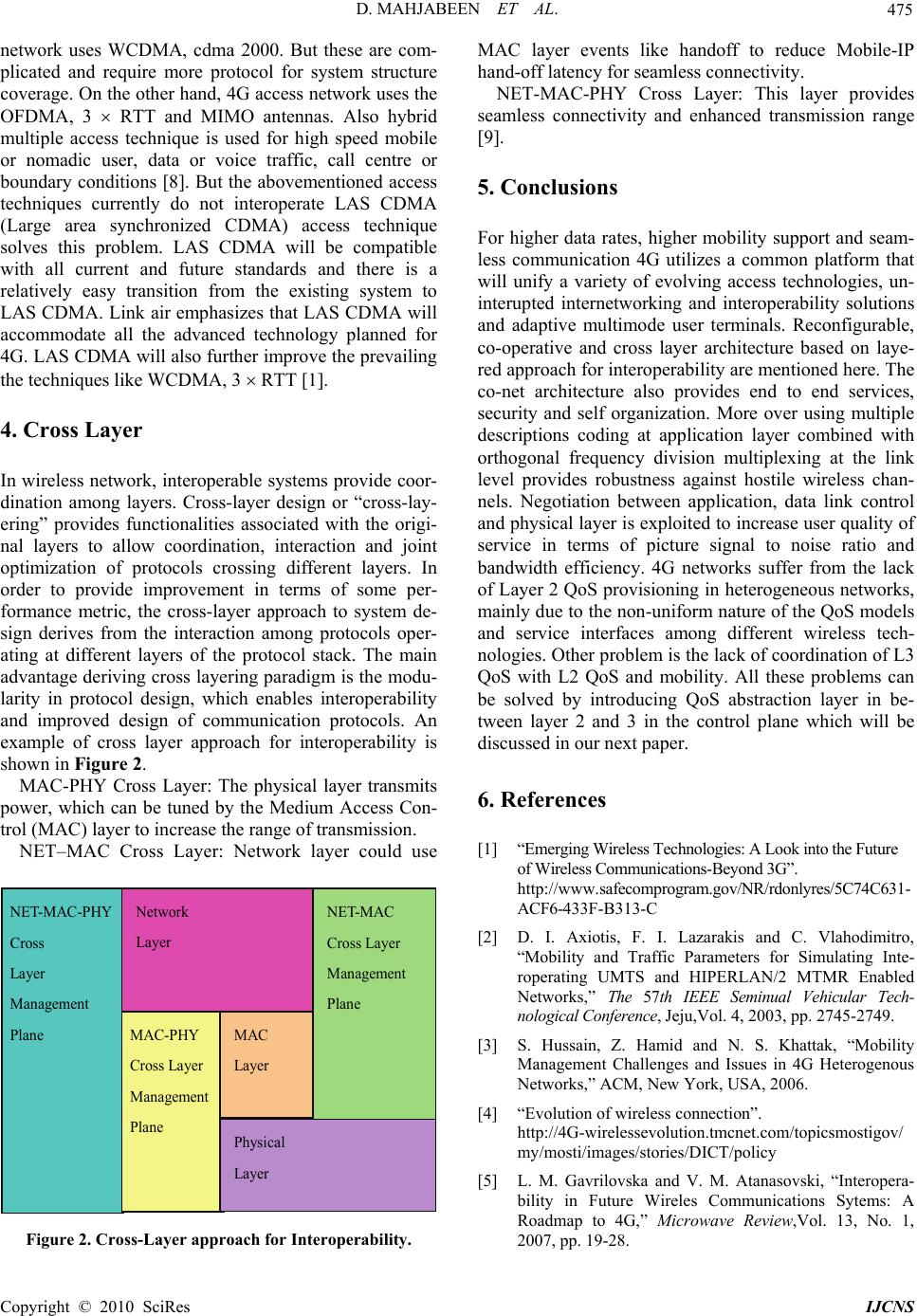Paper Menu >>
Journal Menu >>
 Int. J. Communications, Network and System Sciences, 2010, 3, 472-476 doi:10.4236/ijcns.2010.35063 Published Online May 2010 (http://www.SciRP.org/journal/ijcns/) Copyright © 2010 SciRes. IJCNS Interoperability of Wireless Networks with 4G Based on Layer Modification Dilshad Mahjabeen1, Aminul Haque Mohammed Sayem1, Anis Ahmed2, Shahida Rafique2 1Electrical and Electronics Engineering, Stamford University Bangladesh, Dhaka, Bangladesh 2Applied Physics, Electronics and Communication Engineering, University of Dhaka, Dhaka, Bangladesh E-mail: dil_shadman@yahoo.com Received February 26, 2010; revised March 21, 2010; accepted April 23, 2010 Abstract Fourth generation wireless communication systems feel the necessity of transparent and seamless user roaming with end-to-end connectivity. These systems also demand higher data rate, higher mobility support and QoS guarantees due to rapid development of wireless and mobile networks. These requirements open potentials for the operators to increase their service portfolio and for the users to experience context-rich and personalized services. Consequently the interoperability between different wireless network platforms emerges as a crucial necessity. Here focus is given to the significance of the network interoperability aspect based on layered approach and its role in the development towards 4G. This paper also gives an overview of the major 4G features and differentiating characteristics from other generations. Keywords: 4G, Interoperability, Reconfigurability, Cooperativeness, Cross Layer 1. Introduction Different generations of wireless communication impro- ve the facilities for users day by day. The generations are classified into three groups namely 1G, 2G and 3G. 1G was completely analog and used for only voice trans- mission [1]. 2G networks were built mainly for voice services and slow data transmission. The cellular servi- ces combined with GPRS became 2.5G. This generation provides services such as Wireless Application Protocol (WAP) access, Multimedia Messaging Service (MMS) and for Internet communication services such as email and World Wide Web access. Although 2G is very pop- ular and successful but it lacks single worldwide radio band technology standard as well as inefficient use of sp- ectrum resources for bursty data. 3G networks represent the natural evolution from previous standards. In this case the networks enable network operators to offer users a wider range of more advanced services while achieving greater network capacity through improved spectral eff- iciency. 3G networks offer a greater degree of security than 2G predecessors. This generation (3G) allows sim- ultaneous use of speech and data services and higher data rates. The services provided by 3G are wide-area wireless voice telephone, video calls, and wireless data, all in a mobile environment [2]. However 3G performances may not be sufficient to meet needs of future high quality applications. 3G does not provide mobility and service portability since it is based on primarily a wide-area con- cept. For this facility hybrid network (wireless LAN con- cept and cell or base-station wide area network design) is required. We need all digital packet networks that utilize IP in its fullest form with converged voice and data capa- bility. And this great opportunity will be fulfilled by 4G wireless communications. In this paper we mainly deal with interoperability—the most important and special characteristic of 4G wireless communications. Section II describes the characteristics of 4G and the motivation for 4G other than 3G. This section also differentiates 4G from other generations. Section III focuses how 4G based on layered modification provide interoperability. Section IV describes about the role of cross layer at in- teroperable issue by 4G. 2. Journey towards 4G from 3G The limitations of previous generation lead to improved generation. Their characteristics vary depending on some demanding features. Some of the differentiating charac- teristics are given in Table 1. The first generation of cellular networks consisted of analog systems capable of carrying only voice. 2G were packet switched transfer- ring voice only. 3G is basically a circuit switched cellu-  D. MAHJABEEN ET AL. Copyright © 2010 SciRes IJCNS 473 lar network and so they have their own gateway to inter- pret IP from the back bone network. They also have their own protocol and interfaces for communication within themselves. To make this problem end, the only solution is 4G networks. Moreover, 3G is lacking from the fol- lowings: limitation of spectrum allocation, challenging gradually increasing bandwidth and high data rate for multimedia service, difficulty to roam across distinct service environment, lack of end environment, and lack of end to end continuous transmission mechanism [3]. To face these challenges, the new level of mechanism, 4G communications is introduced. 4G is an all IP packet switched network. This genera- tion is the upgrade strategy in world of wireless commu- nications. 4G system is expected to provide a compre- hensive and secure IP based solution with facilities like voice, data and streamed multimedia. The key character- istics of 4G are global mobility, service portability, sca- lability and seamless handoff. It will be very friendly to comprehensive like “Anytime, Anywhere, Anyhow and Always-on” basis and at much higher data rates compa- red to previous generations. This will secure IP based solution with facilities like voice, data and streamed mul- timedia. Another special characteristic of 4G is the in- teroperability with existing wireless standards [4]. This generation provides integration across different network topologies i.e., hybrid network architecture that inte- grates wireless wide area networks wireless. 3. Interoperability With the rapid development of various wireless commu- nication systems worldwide, there are also gradual chan- ges in users’ expectation and demand. Consequently the corresponding wireless networks work many fold at their capacity limits. So there is every chance of emergency crisis and/or disasters at the peak and crucial period. Th- us interoperability can offer network providers with a possibility to switch between alternative wireless access networks. The basic theme of interoperability will yield the necessity of (user transparent) reconfigurability and Table 1. Comparison of different generations. Properties 2G 3G 4G Network Architecture LAN, Wide area cell-based Hybrid - Driving Architecture Only voice dominantly voice; also data Converged data and voice over IP Switching Packet switched Circuit and Packet All digital with packetized voice Radio Access FDMA, TDMA, CDMA WCDMA, CDMA2000, IWC-136 MC-CDMA, OFDMA Database HLR,VLR, EIR, AuC EHLR, VLR, EIR, AuC EHLR, VLR, EIR, AuC Data rates 9.6 to 384 kbps Up to 2 Mbps 100Mbps Roaming Restricted Global Global Compatible Not compitable to 3G Compitable to 2G, 2G+ and blu- tooth Compatible to 3G Handsets Dual mode TDMA and CDMA Voice and data terminals Multiple mode voice, data, vedio terminals Multiple mode voice, data streamed video at higher data rates. Applica- tions SMS, Internet Internet, SMS Internet, MMS, Mutimedia, HDTV, M TV Bandwidth 25 MHz 5-20 MHz 100 MHz Frequency Band Tri Band800, 900,1800,1900 MHz Dependent on country (1800-2400 MHz) Higher frequency bands (2-8 GHz) Component design Optimized antenna design Optimized antenna design, multi-band adapters Smarter Antennas, software multiband and wideband radios FEC tech Convolutional coding Convolutional rate 1/2, 1/3 Concatenated coding scheme IP No IP Connection A number of air link protocols, including IP 5.0 All IP (IP6.0)  D. MAHJABEEN ET AL. Copyright © 2010 SciRes. IJCNS 474 cooperativeness in various communication systems tun- neling towards the 4G journeys. 3.1. Reconfigurability The reconfigurable interoperability can be done at the network level, the user level or both. This will be very helpful for both the network providers and the users’ perspective. The reconfigurable interoperability will pro- vide selection between alternative wireless access net- works. The selection could be based on several recon- figurable interoperability issues such as: Channel state; Outage probability; Vertical handover probability; Users’ QoS requirements; Context awareness; Load sharing and distribution between different spatially coexisting wireless networks; Efficient spectrum sharing; Preferred gateway selection and network dis- covery and Congestion control. The mechanism of reconfigurability refers not only to the physical layer, but span across the entire protocol stack (including cross-layer optimizations). The recon- figurable interoperability of the heterogeneous 4G sys- tem will lead to more efficient end-to-end connectivity and service delivery in heterogeneous environments, ea- sier worldwide roaming and dynamic adaptation to re- gional contexts, enhanced personalization and richer ser- vices. At the network level, the reconfigurable interop- erability will offer network providers with a possibility to choose between alternative wireless accesses networks at minimal cost. At the user level, the interoperability of the heterogeneous 4G systems will provide more effi- cient end-to-end connectivity and service delivery in heterogeneous environments, easier global roaming and dynamic adaptation to regional contexts, enhanced per- sonalization and enriched services [5]. 3.2. Cooperativeness 3G specify the PHY and MAC of the radio link. This alone is not adequate to build an interoperable broadband wireless network. Interoperable networks involve the following issues: End-to-end service such as IP connectivity; Session management; Security; QoS; Mobility; Connectivity issues; Self organization; Authentication, Authorization, and Accounting. Cooperativeness comes to ensure these issues. This means connectivity between all the entities of a network in a consistent manner across all access technologies for any service. In 4G, a cooperative network (CoNet) con- sists of three distinct layers such as application, connec- tivity and access that form logically separate subsystems. Each of the layers can be further divided into different sub layers as shown in the Figure 1. The layers should have well defined interfaces and be functionally inde- pendent of each other for an approach is required to ens- ure easy adaptation of heterogeneous access technologies, related technology changes, and flexible support for rap- id service innovation. Actually the connectivity layer pl- ays an important role for cooperation across various real- izations of networks, which in turn ensures the interoper- ability. This layer will be independent of the various tra- nsport technologies used to link the nodes of the network together. Finally, the user will enjoy seamless roaming across different access technologies and administrative domains without any manual user intervention [6]. One of the 4G’s major goals is integration, which of- fers seamless interoperability of different types of wire- less networks with the wire line backbone. Some of the available attempted heterogeneous interoperable inte- grated architecture are: a loosely-coupled, Mobile IPv6 (MIPv6)-based GPRS/WLAN/LAN heterogeneous net- work, implementation of IPv6-based mobility-enabled network architecture with Authentication, Authorization, Accounting and Charging (AAAC) services and support for Quality of Service (QoS) [7]. 3.3. Access Network From the point of view of access network, 3G access Application Layer User Plane Control Plane Management Plane Connectivity Layer Network Control Sub Layer Transport Sub Layer Service Support Sub Layer Service Application Sub Layer Access Layer Figure 1. Layers of 4G providing interoperability.  D. MAHJABEEN ET AL. Copyright © 2010 SciRes IJCNS 475 network uses WCDMA, cdma 2000. But these are com- plicated and require more protocol for system structure coverage. On the other hand, 4G access network uses the OFDMA, 3 RTT and MIMO antennas. Also hybrid multiple access technique is used for high speed mobile or nomadic user, data or voice traffic, call centre or boundary conditions [8]. But the abovementioned access techniques currently do not interoperate LAS CDMA (Large area synchronized CDMA) access technique solves this problem. LAS CDMA will be compatible with all current and future standards and there is a relatively easy transition from the existing system to LAS CDMA. Link air emphasizes that LAS CDMA will accommodate all the advanced technology planned for 4G. LAS CDMA will also further improve the prevailing the techniques like WCDMA, 3 RTT [1]. 4. Cross Layer In wireless network, interoperable systems provide coor- dination among layers. Cross-layer design or “cross-lay- ering” provides functionalities associated with the origi- nal layers to allow coordination, interaction and joint optimization of protocols crossing different layers. In order to provide improvement in terms of some per- formance metric, the cross-layer approach to system de- sign derives from the interaction among protocols oper- ating at different layers of the protocol stack. The main advantage deriving cross layering paradigm is the modu- larity in protocol design, which enables interoperability and improved design of communication protocols. An example of cross layer approach for interoperability is shown in Figure 2. MAC-PHY Cross Layer: The physical layer transmits power, which can be tuned by the Medium Access Con- trol (MAC) layer to increase the range of transmission. NET–MAC Cross Layer: Network layer could use NET-MAC-PHY Cross Layer Management Plane Network Layer MAC-PHY Cross Layer Management Plane MAC Layer Physical Layer NET-MAC Cross Layer Management Plane Figure 2. Cross-Layer approach for Interoperability. MAC layer events like handoff to reduce Mobile-IP hand-off latency for seamless connectivity. NET-MAC-PHY Cross Layer: This layer provides seamless connectivity and enhanced transmission range [9]. 5. Conclusions For higher data rates, higher mobility support and seam- less communication 4G utilizes a common platform that will unify a variety of evolving access technologies, un- interupted internetworking and interoperability solutions and adaptive multimode user terminals. Reconfigurable, co-operative and cross layer architecture based on laye- red approach for interoperability are mentioned here. The co-net architecture also provides end to end services, security and self organization. More over using multiple descriptions coding at application layer combined with orthogonal frequency division multiplexing at the link level provides robustness against hostile wireless chan- nels. Negotiation between application, data link control and physical layer is exploited to increase user quality of service in terms of picture signal to noise ratio and bandwidth efficiency. 4G networks suffer from the lack of Layer 2 QoS provisioning in heterogeneous networks, mainly due to the non-uniform nature of the QoS models and service interfaces among different wireless tech- nologies. Other problem is the lack of coordination of L3 QoS with L2 QoS and mobility. All these problems can be solved by introducing QoS abstraction layer in be- tween layer 2 and 3 in the control plane which will be discussed in our next paper. 6. References [1] “Emerging Wireless Technologies: A Look into the Future of Wireless Communications-Beyond 3G”. http://www.safecomprogram.gov/NR/rdonlyres/5C74C631- ACF6-433F-B313-C [2] D. I. Axiotis, F. I. Lazarakis and C. Vlahodimitro, “Mobility and Traffic Parameters for Simulating Inte- roperating UMTS and HIPERLAN/2 MTMR Enabled Networks,” The 57th IEEE Seminual Vehicular Tech- nological Conference, Jeju,Vol. 4, 2003, pp. 2745-2749. [3] S. Hussain, Z. Hamid and N. S. Khattak, “Mobility Management Challenges and Issues in 4G Heterogenous Networks,” ACM, New York, USA, 2006. [4] “Evolution of wireless connection”. http://4G-wirelessevolution.tmcnet.com/topicsmostigov/ my/mosti/images/stories/DICT/policy [5] L. M. Gavrilovska and V. M. Atanasovski, “Interopera- bility in Future Wireles Communications Sytems: A Roadmap to 4G,” Microwave Review,Vol. 13, No. 1, 2007, pp. 19-28.  D. MAHJABEEN ET AL. Copyright © 2010 SciRes. IJCNS 476 [6] “Cooperative Networks of 4G”. www-scf.usc/edu/~ssaraf/ EE555.pdf [7] L. Gavrilovska, V. Atanasovski, V. Rakovic, O. Ognenoski and A. Momiroski, “Providing Interoperability in Hetero- geneous Environments towards 4G,” ELMAR, 50th Inter- national Symposium, Zadar, Vol. 1, 2008, pp. 223-226. [8] L. D. Uomo and E. Scarrone, “All-IP 4G Network arc- hitecture for Efficient Mobility and Resource Manageme- nt,” 5th International Symposium on Wireless Personal Multimedia Communications, Honolulu, Vol. 2, 2002, pp. 591-595. [9] D. Kliazovich, M. Devetsikiotis and F. Granelli, “Formal Methods in Cross Layer Modeling and Optimization of Wireless Networks,” In: Kotsopoulos, S. and Ioannou, K. Ed., Handbook of Research on Heterogeneous next Generation Networking: Innovations and Platforms, 2009, pp. 1-24. |

